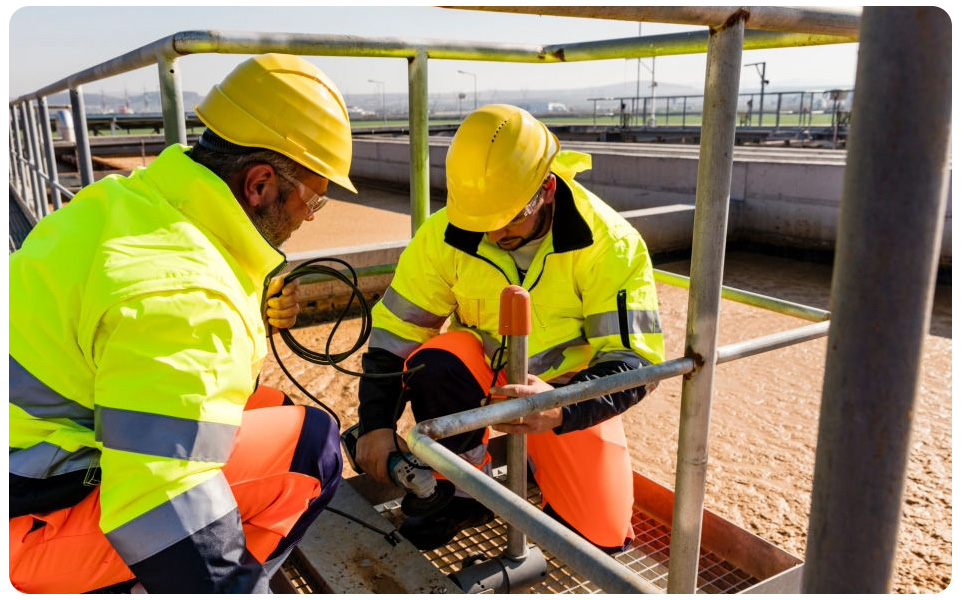Construction Electrician – LV ( 6 month course)
Construction Electrician – LV click here
Brief Job Description
This job role is responsible for laying of cables, installation, and maintenance of equipment like motors, bar cutting machine, bar shearing machine etc. at construction site as per the requirement of construction
activities. The responsibilities also include carrying out permanent wiring and assisting the foreman in
electrification of buildings. The job holder uses the electrical drawings, diagrams, and related documents
to carry out the activities.

Personal Attributes
The construction electrician – LV is expected to be physically fit to work across various locations with
varied environmental conditions. The person should be organized, diligent, methodical, safety-conscious,
and a prompt decision-maker. In addition to being a team player, the individual should have good
communication skills.
Lay (single/ three phase) cable and provide electrification for equipment at construction sites
Description
This unit describes the skills and knowledge required to lay (single/ three-phase) cable and provide
electrification for equipment at construction sites
Scope
The scope covers the following :
Prepare for cable laying
Lay cable and provide electrification for construction equipment
Elements and Performance Criteria
Prepare for cable laying
To be competent, the user/individual on the job must be able to:
PC1. assist superior in planning (method, material specification, time requirement) of cable laying
activity at construction sites
PC2. read and interpret electrical drawings, specifications, manufacturers guidelines as and when
required
PC3. check cables, lights and accessories to be used according to instructions/ drawings/
manufacturers specifications as per applicability
PC4. inspect work area for embedded service lines, presence of water table, and vicinity of
flammable items prior to cable laying
PC5. carry out safe isolation of power source as per applicable specification/ electrical safety
norms and erect caution signages at appropriate location
PC6. arrange for execution of preparatory activities such as digging of trenches, laying of
conduits, erection of poles etc.
PC7. fill up necessary permits, checklists as per organizational norms for preparatory activities
Lay cable and provide electrification for construction equipment
To be competent, the user/individual on the job must be able to:
PC8. lay cables according to standard practice through trenches, conduits or by means of poles at
construction sites
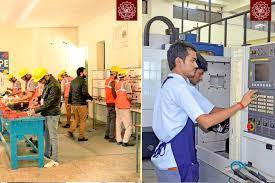
PC9. check for rigidity of poles, condition of exposed cables and fittings, depth and backfilling of
trenches, proper barricading as per safety norms as and when necessary
PC10. connect cable to power source and electrical equipment/ machinery as per manufacturers
guidelines or standard practice
PC11. carry out proper termination of cables as per specification or standard practice
PC12. install circuit breakers, starters, relays etc. of correct power rating as per specification of the
equipment
PC13. carry out earthing of the equipment (if applicable) by suitable method
PC14. carry out trial run and perform applicable electrical tests to ensure safe and desired working
of construction equipment
PC15. secure exposed cables and its accessories against man, vehicular movement or any other
external abrasive effects by adopting suitable insulation methods or industry recognized
standard practices
PC16. ensure upkeep of all electrical tools and equipment under operation, according to
manufacturers guidelines or standard procedures
PC17. ensure tagging of embedded, exposed electrical lines, its accessories and other equipment
PC18. ensure proper housekeeping of the work area
Knowledge and Understanding (KU)
The individual on the job needs to know and understand:
KU1. standard practices for establishing temporary LV power connection arrangement at the
construction site
KU2. safety rules and regulations for handling and storing relevant tools, equipment, and
materials for electrical works in accordance with organizational norms
KU3. importance of personal protection including the use of related safety gears & equipment in
accordance with organizational norms
KU4. service request procedures for tools, materials and equipment as per organizational norms
KU5. guidelines provided in Indian Standard code of practice applicable to electrical works
KU6. wiring symbols used in single and three phase connections
KU7. how to read and interpret single line diagram (SLD), and schematics, wiring diagrams of
electrical connection
KU8. manufacturers guidelines/ specifications for use of hand and power tools and measuring
devices
KU9. electrical units of measurements and their signs (such as Watt, Ampere, Ohm, volt etc.)
KU10. concept of AC, DC, circuits and their respective properties
KU11. concept about working principle of AC and DC circuits and factors related to the same
KU12. sequencing and executing cable laying at construction sites as per standard practice, plans
or instructions
KU13. concept of 3 phase circuit and its advantages over single-phase connection, star and delta
connection
KU14. requirement of cables and accessories (single phase/ 3 phase) of equipment
KU15. features of AC single phase and 3 phase connections including star and delta connections
KU16. tests to be performed in balanced 3 phase circuits
KU17. checks to be done for the cables and their laying locations at construction sites to ensure
safe working condition
KU18. standard procedures of safeguarding exposed cables against external damages
KU19. the process of measuring resistance, electrical current flow, voltage as per requirement
using appropriate electrical measuring devices like digital multimeter, tong tester, digital
voltmeter, etc.
KU20. safe method of electrical isolation and use of tools in the operation
KU21. different methods of earthing including measurement of earth resistance by earth tester,
testing of earth Leakage by ELCB and relay, etc.
KU22. standard procedure of termination of cables at the power sources and equipment
KU23. use of MCB, RCCB and ELCB in equipment, their working principles and power ratings
KU24. concepts of electrical circuits which includes properties and functions of RCL circuits,
inductive DC, AC circuits, details of capacitors, inductors and their actions in DC, AC circuits
KU25. type of connections and tests to be carried out in capacitive, inductive AC and DC circuits
KU26. operational characteristics of electrical systems and internal components
Generic Skills (GS)
User/individual on the job needs to know how to:
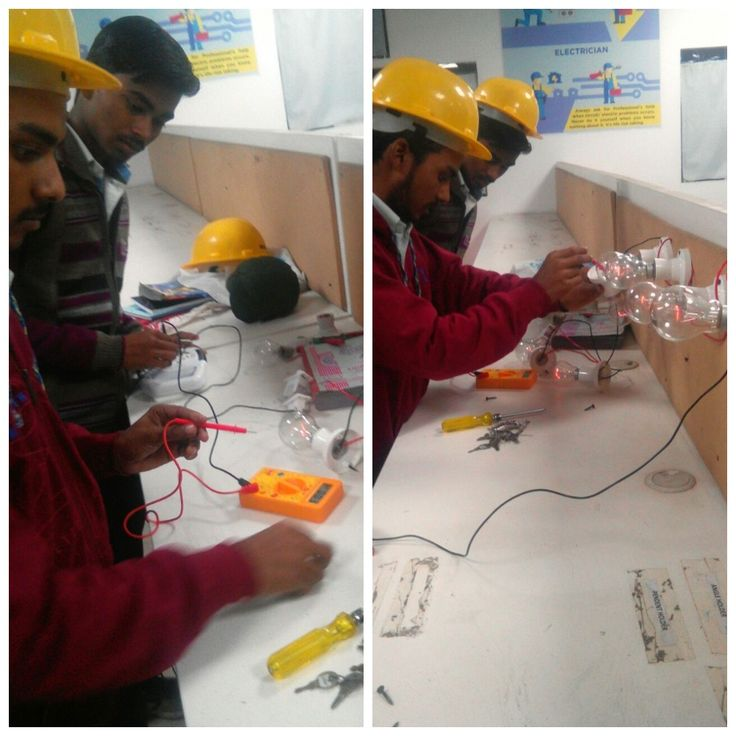
GS1. write in at least two languages, preferably the local language at the site and basic English
GS2. read SLDs, work, and safety-related instructions/signboards in one or more languages,
preferably in the local language of the site
GS3. speak in at least one language, preferably in one of the local languages of the site
GS4. listen attentively to instructions communicated by supervisors
GS5. communicate orally and efficiently with team members
GS6. plan work and organize required resource effectively
GS7. complete work as per agreed time schedule and quality parameters
GS8. resolve any conflict within the team members
GS9. analyze the safety aspect of the workplace
GS10. evaluate the complexity of the tasks
GS11. identify any violation of safety norms during the work
Inspect electrical maintenance of construction equipment as per requirement
Description
This unit describes the skills and knowledge required to inspect electrical maintenance of construction
equipment as per the requirement.
Scope
The scope covers the following :
Carry out repair and maintenance of cables and construction equipment
Elements and Performance Criteria
Carry out repair and maintenance of cables and construction equipment
To be competent, the user/individual on the job must be able to:
PC1. carry out appropriate tests and diagnose electrical faults of equipment as and when
necessary
PC2. power off equipment under maintenance or take necessary precautions as per standard
practice while performing tests on live circuits
PC3. carry out safe isolation at power source as per applicable specification/ electrical safety
norms and erect caution signages at appropriate location
PC4. determine the type (DC/AC) of motors to be repaired or installed
PC5. repair or replace faulty parts according to the power rating and manufacturers guideline
relevant to circuit under maintenance
PC6. use appropriate motor starters according to the specification and power rating of motors
during maintenance
PC7. carry out winding in armatures of motor if required as per specification of motor
PC8. inspect and rectify faults detected in earthing of construction equipment, referring to
manufacturers guidelines
PC9. replace faulty parts like relays, MCBs, wires, switches, sockets etc.
PC10. inspect leakage, faults in LV single/ three phase power distribution wirings as per directions,
standard practices
PC11. operate and inspect transformers to detect faults under close supervision
PC12. carry out maintenance of lighting arrangements installed at critically accessable locations
such as tower cranes, high masts etc. and replace faulty parts, consumables as and when
required
PC13. join damaged armored cables (bearing heavy electricity loads) using straight through joints
efficiently

PC14. operate changeover switches for switching between main power supply & DGS as per
requirement
PC15. ensure safe and desired working of temporary electrical panels/ distribution boards at
construction sites
PC16. notify concerned authorities prior to undertaking maintenance activity as per applicable
organizational norms
PC17. document readings, conclusions of tests performed as per requirement
Knowledge and Understanding (KU)
The individual on the job needs to know and understand:
KU1. standard practices and procedures for maintenance of temporary electrical works / panels
KU2. safety rules and regulations for handling and storing relevant tools, equipment, and
materials for electrical works in accordance with organizational norms
KU3. importance of personal protection including the use of related safety gears & equipment in
accordance with organizational norms
KU4. service request procedures for tools, materials and equipment as per organizational norms
KU5. guidelines provided in Indian Standard code of practice applicable to electrical works
KU6. wiring symbols used in single and three phase connections
KU7. how to read and interpret single line diagram (SLD), and schematics, wiring diagrams of
electrical connection
KU8. type of cables (single phase/ 3 phase) are to be used based on electrical load requirement of
circuits, insulations and type of equipment to be installed
KU9. use of measuring devices like digital multimeter, tong tester, digital voltmeter while
establishing electrical connections to the equipment at construction sites
KU10. concepts of electrical circuits which includes properties and functions of RCL circuits,
inductive DC, AC circuits, details of capacitors, inductors and their actions in DC, AC circuits
KU11. type of connections and tests to be carried out in capacitive, inductive AC and DC circuits
KU12. working principle of different types of motors and their respective uses
KU13. concept of star, delta connection and their uses in electrical circuits
KU14. concept and working principle of various type of starters used in DC motors such as 3point, 4
point etc. as well as 3 phase squirrel cage induction motors such as DOL, Star-Delta etc.
KU15. working principle of different types of 3 phase transformers, connections (starter, delta delta, delta-star) and their components
KU16. basic concept of application of respective transformers and relevant terminologies like
magnetic flux, winding, current and voltage ratio, core and shell construction etc
KU17. different methods of earthing including measurement of earth resistance by earth tester,
testing of earth Leakage by ELCB and relay, etc.
KU18. standard procedure of termination of cables at the power sources and equipment
KU19. use of MCB, RCCB and ELCB in equipment , their working principles and power ratings
KU20. operational characteristics of electrical systems and internal components
Generic Skills (GS)
User/individual on the job needs to know how to:
GS1. write in at least two languages, preferably the local language at the site and basic English
GS2. read SLDs, work and safety-related instructions/signboards in one or more languages,
preferably in the local language of the site
GS3. speak in at least one language, preferably in one of the local languages of the site
GS4. communicate orally and efficiently with team members
GS5. analyze the safety aspect of the workplace
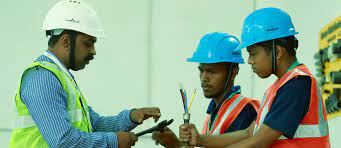
GS6. plan work and organize required resource effectively
GS7. complete work as per agreed time schedule and quality parameters
GS8. resolve any conflict within the teammates
GS9. evaluate the complexity of the tasks
GS10. identify any violation of safety norms during the work
Carry out LV electrical wiring and assist the foreman in building electrification works
Description
This unit describes the skills and knowledge required to carry out LV electrical wiring and provide
assistance in building electrification works.
Scope
The scope covers the following :
Perform concealed / exposed wiring and electrification
Install and maintain electrical fixtures/ fittings, earthing arrangement and home appliances
Elements and Performance Criteria
Perform concealed /exposed wiring and electrification
To be competent, the user/individual on the job must be able to:
PC1. perform visual checks of the house wiring components (such as wires, flexible and rigid
conduits, PVC raceways, wooden battens, clamps etc.) prior to its use in concealed wiring
PC2. read and interpret single phase wiring diagram and assist in estimation of required materials
PC3. carry out necessary measurements of cables/ conduits to meet working needs and in order
to carry out marking on wall
PC4. mark the walls for chasing for concealed wiring, and monitor the chasing work
PC5. assist in planning for electrification, and mark locations for installation of raceways and
electrical fixtures/ fittings on the walls
PC6. lay flexible conduit pipes through RCC structures (slabs, beams, walls) or through chased
wall (brick wall) surface as per instruction
PC7. ensure to lock conduit pipe in its location using clamps or other standard means
PC8. place wires through conduits and raceways ensuring that wires are as per specification and
numbers
PC9. carry out drilling and cutting works as per requirement
Install and maintain electrical fixtures/ fittings, earthing arrangement and home appliances
To be competent, the user/individual on the job must be able to:
PC10. prepare tentative budget for household wiring and electrification work
PC11. calculate electrical material requirements based on electrical fittings and layouts
PC12. carry out safe isolation of power source as per applicable specification/ electrical safety
norms and erect caution signages at appropriate location
PC13. install electrical fixtures, fittings (such as DBs, switch boards, switches, sockets, lights and
wall brackets) at specified locations and carry out termination of cables as per standard
practice
PC14. perform necessary tests to ensure safe condition of electrical circuit during and post wiring
activity using appropriate tools
User/individual on the job needs to know how to:
GS1. write in at least two languages, preferably the local language at the site and basic English
GS2. read SLDs, work and safety-related instructions/signboards in one or more languages,
preferably in the local language of the site
GS3. communicate orally and effectively with team members
GS4. decide on the safety of the workplace and ensure the work does not create hazardous
conditions
GS5. plan work and organize required resource effectively
GS6. complete work as per agreed time schedule and quality parameters
GS7. resolve any conflict within the teammates
GS8. evaluate the complexity of the tasks
GS9. identify any violation of safety norms during the work
Work effectively in a team to deliver desired results at the workplace
Description
This unit describes the skills and knowledge required to work effectively within a team to achieve the
desired results
Scope
The scope covers the following :
Interact and communicate in an effective manner
Support co-workers to execute the project requirements
Practice inclusion
Elements and Performance Criteria
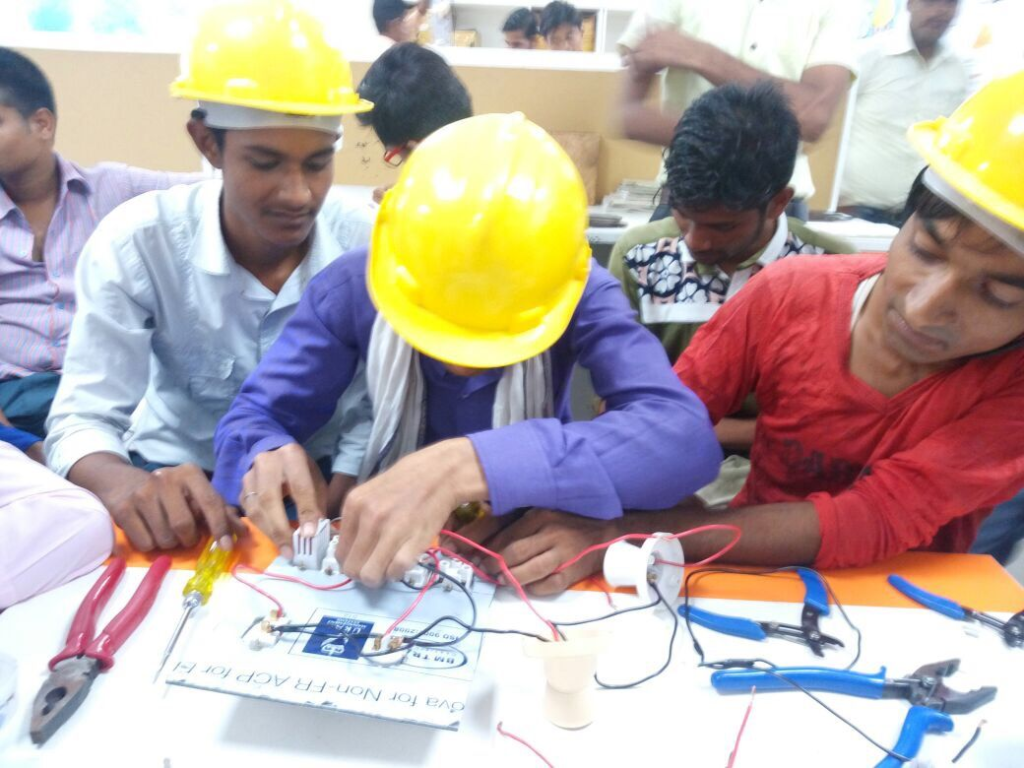
Interact and communicate in an effective manner
To be competent, the user/individual on the job must be able to:
PC1. pass on work related information/ requirement clearly to the team members
PC2. inform co-workers and superiors about any kind of deviations from work
PC3. report any unresolved problem to the supervisor immediately
PC4. obtain instructions from superiors and respond on the same
PC5. communicate to team members/subordinates for appropriate work technique and method
PC6. seek clarification and advice as per the requirement
Support co-workers to execute the project requirements
To be competent, the user/individual on the job must be able to:
PC7. hand over the required material, tools, tackles, equipment and work fronts timely to
interfacing teams
PC8. work together with co-workers in a synchronized manner
Practice inclusion
To be competent, the user/individual on the job must be able to:
PC9. maintain cultural inclusivity at work place
PC10. maintain disability friendly work practices
PC11. follow gender neutral practices at workplace
PC12. address discriminatory and offensive behavior in a professional manner as per
organizational policy
Knowledge and Understanding (KU)
The individual on the job needs to know and understand:
KU1. own roles and responsibilities
KU2. importance of effective communication
KU3. the consequence of poor teamwork on project outcomes, timelines, safety at the
construction site, etc.
KU4. different modes of communication used at workplace
KU5. importance of creating healthy and cooperative work environment among the gangs of
workers
KU6. different activities within the work area where interaction with other workers is required
KU7. applicable techniques of work, properties of materials used, tools and tackles used, safety
standards that co-workers might need as per the requirement
KU8. importance of proper and effective communication and the expected adverse effects in case
of failure relating to quality, timeliness, safety, risks at the construction project site
KU9. importance and need of supporting co-workers facing problems for the smooth functioning of
work
KU10. the fundamental concept of gender equality
KU11. how to recognize and be sensitive to issues of disability, culture and gender
KU12. legislation, policies, and procedures relating to gender sensitivity and cultural diversity
including their impact on the area of operation
Generic Skills (GS)
User/individual on the job needs to know how to:
GS1. write in at least one language, preferably in the local language of the site
GS2. read the communication regarding work completion, materials used, tools and tackles used,
the resource required, etc.,
GS3. speak in one or more languages, preferably in one of the local language of the site
GS4. listen and follow instructions / communication shared by superiors/ co-workers regarding
team requirements or interfaces during work processes
GS5. communicate orally and effectively with co-workers considering their educational and social
background
GS6. decide on what information is to be shared with co-workers within the team or to the
interfacing gang of workers
GS7. plan work and organize the required resources in coordination with team members
GS8. complete all assigned task in coordination with team members
GS9. take initiative in resolving issues among co-workers or report the same to superiors
GS10. ensure best ways of coordination among team members
GS11. evaluate the complexity of task and determine if any guidance is required from superiors
Plan and organize work to meet expected outcomes
Description
This unit describes the knowledge and the skills required for an individual to plan and organize own work in order to meet expected outcome
.
Scope
The scope covers the following :
Plan and prepare for work
Organize required resources as per work plan
Complete work as per the plan
Elements and Performance Criteria
Plan and prepare for work
To be competent, the user/individual on the job must be able to:
PC1. identify the targets and timelines set by superiors
PC2. determine the work requirements corresponding to
task(drawings/schedules/instructions/methodology), safety, tools and equipment prior to
commencement of task
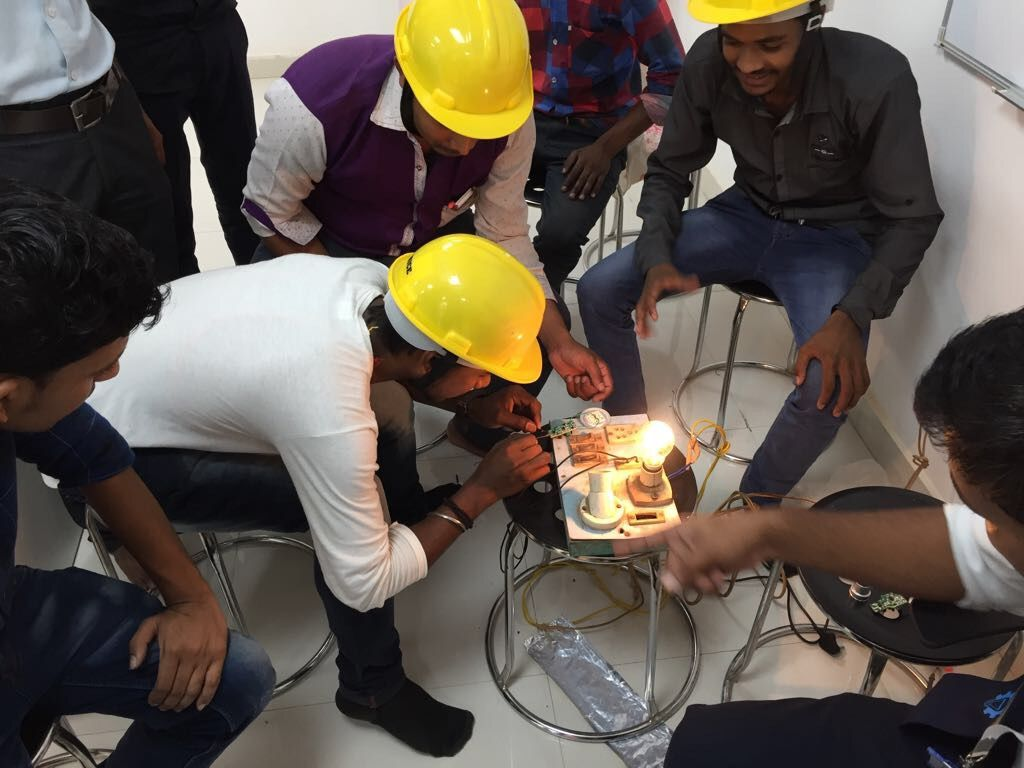
PC3. plan the work by analyzing the required outcomes, work procedures, allotted time, resource
availability and known priorities
PC4. prepare the work areas in coordination with team members
PC5. plan for waste collection and disposal prior to and after completion of work
Organize required resources as per work plan
To be competent, the user/individual on the job must be able to:
PC6. arrange the required manpower prior to commencement of work
PC7. organize the required materials, tools and tackles required for the task
Complete work as per the plan
To be competent, the user/individual on the job must be able to:
PC8. engage allocated manpower in an appropriate manner
PC9. employ correct tools, tackles and equipment for the desired work
PC10. provide guidance to the subordinates to obtain desired outcome
PC11. use resources in an optimum manner to avoid any unnecessary wastage
PC12. use tools, tackles and equipment carefully to avoid damage
PC13. ensure the work processes adopted are in line with the specified standards and instructions
PC14. complete the work with the allocated resources within specified time
PC15. clean and organize the workplace after completion of task
Knowledge and Understanding (KU)
The individual on the job needs to know and understand:
KU1. importance of proper housekeeping including safe waste disposal
KU2. policies, procedures and work targets set by superiors
KU3. how to identify work activities that need to be planned and organized
KU4. how to determine the task requirements
KU5. how to determine the quality requirements related to the task
KU6. how to undertake all aspect of planning and organizing the task, including interpretation of
task, reading drawing/schedules, arranging resources, reporting problems etc.
KU7. how to implement the planned activities
KU8. how to use available resources in a judicious and appropriate manner to minimize wastages or
damage
Generic Skills (GS)
User/individual on the job needs to know how to:
GS1. write in one or more language, preferably the local language at the site
GS2. read communication from co-workers, superiors and notices from other departments as per
requirement of the level
GS3. speak in one or more language, preferably one of the local language at the site
GS4. follow communication shared by co-workers regarding standard work processes, resources
available, timelines, etc.
GS5. communicate effectively with co-workers and subordinates
GS6. decide on what sequence is to be adopted for execution of work
GS7. plan and organize the materials, tools, tackles and equipment required to execute the work
GS8. complete all assigned task with proper planning and organizing
GS9. analyze areas of work which could result in a delay of work, wastage of material or damage
to tools and tackles
GS10. evaluate potential solutions to minimize avoidable delays and wastages at the construction
site
Work according to personal health, safety and environment protocols at construction site
Description
This NOS covers the skill and knowledge required for an individual to work according to personal health,
safety and environmental protocols at construction site
Scope
The scope covers the following :
Follow safety norms as defined by organization
Adopt healthy & safe work practices
Implement good housekeeping and environment protection process and activities
Follow infection control guidelines as per applicability
Elements and Performance Criteria
Follow safety norms as defined by the organization
To be competent, the user/individual on the job must be able to:
PC1. identify and report any hazards, risks or breaches in site safety to the appropriate authority
PC2. follow emergency and evacuation procedures in case of accidents, fires, natural calamities
PC3. follow recommended safe practices in handling construction materials, including chemical
and hazardous material whenever applicable
PC4. follow all the protocols and safety techniques conveyed during safety awareness programs
like Tool Box Talks, safety demonstrations and mock drills conducted at the site
PC5. select and operate different types of fire extinguishers corresponding to various types of fires
as per EHS guideline
PC6. identify near miss, unsafe condition and unsafe act
Adopt healthy & safe work practices
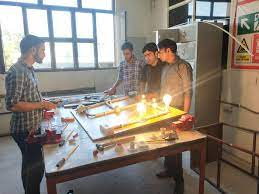
To be competent, the user/individual on the job must be able to:
PC7. use appropriate Personal Protective Equipment (PPE) as per work requirements for : Head
Protection, Ear protection, Fall Protection ,Foot Protection, Face and Eye Protection, Hand
and Body Protection , and Respiratory Protection (if required)
PC8. handle all required tools, tackles, materials and equipment safely
PC9. follow safe disposal of waste, harmful and hazardous materials as per EHS guidelines
PC10. check and install all safety equipment as per standard guidelines
PC11. follow safety protocols and practices as laid down by site EHS department
PC12. obtain “height pass” clearance for working at heights
Implement good housekeeping practices
To be competent, the user/individual on the job must be able to:
PC13. collect, segregate and deposit construction waste into appropriate containers based on their
toxicity or hazardous nature
PC14. apply ergonomic principles wherever required
Follow infection control guidelines as per applicability
To be competent, the user/individual on the job must be able to:
PC15. follow recommended personal hygiene, workplace hygiene and sanitization practices
PC16. clean and disinfect all materials, tools and supplies before and after use
PC17. report immediately to concerned authorities regarding signs and symptoms of illness of self
and others
Knowledge and Understanding (KU)
The individual on the job needs to know and understand:
KU1. reporting procedures in cases of breaches or hazards for site safety, accidents, and
emergency situations as per guidelines
KU2. types of safety hazards at construction sites
KU3. basic ergonomic principles as per applicability
KU4. the procedure for responding to accidents and other emergencies at site
KU5. use of appropriate personal protective equipment based on various working conditions
KU6. importance of handling tools, equipment, and materials as per applicable norms
KU7. effect of construction material on health and environments as per applicability
KU8. various environmental protection methods as per applicability
KU9. storage of waste including non-combustible scrap material and debris, combustible scrap
material and debris, general construction waste and trash (non-toxic, non-hazardous), any
other hazardous wastes and any other flammable wastes at the appropriate location
KU10. how to keep the workplace neat and tidy so as to be safe
KU11. how to use hazardous material in a safe and appropriate manner as per applicability
KU12. types of fire
KU13. procedure of operating different types of fire extinguishers
KU14. safety relevant to tools, tackles, and equipment as per applicability
KU15. housekeeping activities relevant to task
KU16. ways of transmission of infection
KU17. ways to manage infectious risks at the workplace
KU18. different methods of cleaning, disinfection, sterilization, and sanitization
KU19. symptoms of infection like fever, cough, redness, swelling, and inflammation
Generic Skills (GS)
User/individual on the job needs to know how to:
GS1. write in at least one language, preferably in the local language of the site
GS2. fill safety formats for near miss, unsafe conditions and safety suggestions
GS3. read in one or more language, preferably in the local language of the site
GS4. speak in one or more language, preferably in one of the local language of the site
GS5. listen to instructions/communication shared by site EHS and superiors regarding site safety,
and conducting the toolbox talk
GS6. identify potential safety risks and report to the appropriate authority
GS7. assess and analyze areas which may affect health, safety and environment protocol on the
site




